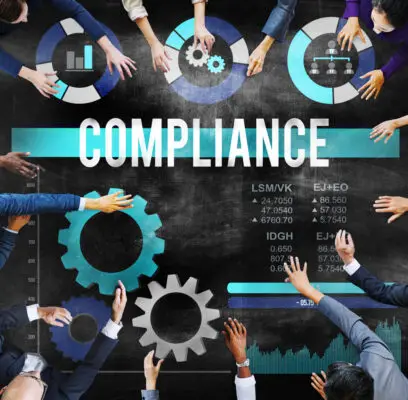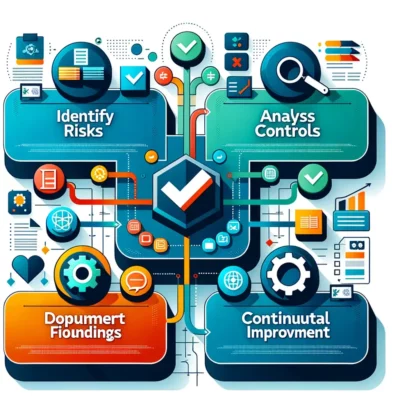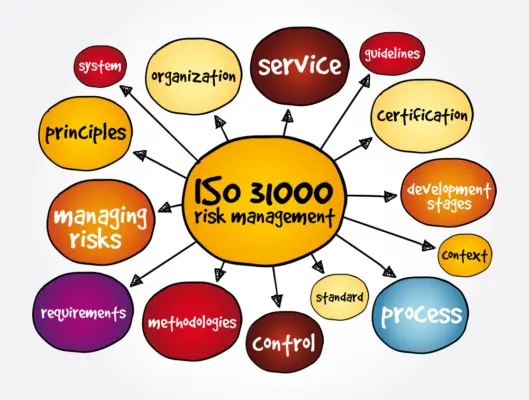A Compliance Risk Assessment Template is a tool organizations use to identify, assess, and manage legal and regulatory compliance risks.
It helps ensure that a company adheres to laws, regulations, industry standards, and ethical practices pertinent to its operations. Here’s a comprehensive guide to creating a Compliance Risk Assessment Template:
- Set Clear Objectives and Planning: Begin by defining the scope and objectives of the risk assessment. This includes determining the regulatory requirements and the business processes to be assessed. Setting clear goals helps to focus the assessment on areas of highest risk and importance. (ZenGRC)
- Risk Identification and Analysis: Identify potential compliance risks that could affect the organization. This involves a thorough review of all business areas, processes, and functions to pinpoint where compliance risks are likely to occur. (ZenGRC)
- Evaluate Risks: Once risks are identified, evaluate them based on their likelihood and potential impact. This helps prioritize risks and determine where to allocate resources for mitigation.
- Mitigation Strategies: Develop strategies and controls to reduce the identified risks to acceptable levels. This may involve revising policies, implementing new procedures, or providing additional training to employees.
- Monitoring and Review: Regularly monitor compliance risks and the effectiveness of the mitigation strategies. This should be an ongoing process, with periodic reviews to ensure that the risk assessment remains current and relevant.
- Documentation: Maintain comprehensive documentation of the risk assessment process, findings, and actions. This serves as evidence of due diligence in the event of a regulatory inquiry or audit. (Coker Group PDF)
A compliance risk assessment is essential for organizations to identify, evaluate, and manage risks arising from non-compliance with laws, regulations, or internal policies. A compliance risk assessment template is a tool that helps organizations conduct this assessment in a structured and consistent manner.
The template includes questions or criteria used to evaluate the organization’s compliance risks, assess the likelihood and impact of these risks, and identify risk management strategies.
Understanding compliance risk is the first step in developing a compliance risk assessment template. Compliance risk refers to the risk of legal or regulatory sanctions, financial loss, or reputational damage that an organization may face due to non-compliance with laws, regulations, or internal policies.
Compliance risks can arise from various sources, such as changes in regulations, new business practices, or third-party relationships.
Components of a compliance risk assessment template may vary depending on the organization’s size, industry, and regulatory environment.

However, some common components include identifying the organization’s compliance objectives, assessing the regulatory environment and changes, identifying compliance gaps, and developing risk management and mitigation strategies.
Compliance policies and procedures, monitoring and reporting, and stakeholder engagement and communication are also essential components of a compliance risk assessment.
Key Takeaways
- A compliance risk assessment template is a structured and consistent tool that helps organizations to identify, evaluate, and manage compliance risks.
- Compliance risk refers to the risk of legal or regulatory sanctions, financial loss, or reputational damage that an organization may face due to non-compliance with laws, regulations, or internal policies.
- Components of a compliance risk assessment template include identifying compliance objectives, assessing the regulatory environment and changes, identifying compliance gaps, and developing risk management and mitigation strategies.
Understanding Compliance Risk
Defining Compliance Risk
Compliance risk is the potential loss an organization may face due to its failure to comply with laws, regulations, and standards that govern its operations.
The risk of legal or regulatory sanctions, financial losses, or damage to reputation can arise from violations of compliance requirements.
Compliance risk can arise from various sources, including non-compliance with regulatory requirements, internal policies and procedures, and ethical standards.
Compliance risk can be broken down into three main components: legal, regulatory, and reputational. Legal risk is the risk of financial loss or other damage to an organization due to a breach of laws or regulations.
Regulatory risk is the risk of financial loss or other damage to an organization due to a breach of regulatory requirements.
Reputational risk is the risk of damage to an organization’s reputation due to a breach of ethical or social responsibility standards.
Relevance to Organizations
Compliance risk assessment is essential for organizations to effectively identify, assess, and manage their compliance risks. Compliance risk assessment helps organizations to identify potential compliance issues and to take proactive measures to mitigate those risks.
It is an ongoing process that involves identifying and assessing compliance risks, evaluating the effectiveness of existing controls, and implementing new controls as needed.
Compliance risk assessment is particularly relevant to organizations that operate in highly regulated industries such as finance, healthcare, and energy.
These industries are subject to various regulatory requirements, and failure to comply with these requirements can result in significant financial and reputational damage.
Compliance risk assessment is critical for organizations to identify and mitigate their compliance risks. It helps organizations to ensure that they are operating in compliance with applicable laws, regulations, and standards and to protect themselves from potential legal, financial, and reputational damage.
Components of Compliance Risk Assessment
Compliance risk assessment is a crucial process that helps organizations identify, evaluate, and manage potential risks associated with their operations. A well-designed compliance risk assessment template should include the following components:
Risk Identification
The first step in compliance risk assessment is identifying and documenting all potential risks associated with an organization’s operations.
This can be done through various methods, such as brainstorming sessions, surveys, and employee interviews. Once all risks have been identified, they should be documented in a risk register, including the risk description, likelihood, severity, and potential impact.
Risk Analysis
After identifying the risks, the next step is to analyze them in detail. This involves assessing the likelihood of the risk occurring and its potential impact on the organization.
Risk analysis should also include evaluating the risk factors that contribute to the likelihood and severity of the risk. For example, if the risk is related to data security, risk factors could include the type of data being processed, the number of employees accessing the data, and the security measures in place to protect the data.
Risk Evaluation
The final step in compliance risk assessment is to evaluate the identified risks and determine the appropriate risk response strategy.
This involves assigning a risk rating to each risk based on its likelihood and potential impact. High-risk risks should be prioritized for immediate action, while low-risk risks may be monitored and reviewed periodically.
Risk response strategies may include risk avoidance, mitigation, transfer, or acceptance.
In conclusion, compliance risk assessment is a critical process that helps organizations identify and manage potential risks associated with their operations.
Organizations can proactively manage risks by following a well-designed compliance risk assessment template that includes the above components and ensures compliance with applicable regulations.
Compliance Policies and Procedures
Developing and implementing compliance policies and procedures is critical to any compliance program. Policies and procedures serve as a roadmap for employees to follow and ensure that the organization complies with applicable regulations and industry standards.
Developing Internal Policies
The first step in developing internal policies is identifying the applicable regulations and industry standards the organization must comply with.
Once identified, the organization can develop policies that outline the processes and procedures necessary to comply with these standards.
Policies should be written in clear and concise language and should include the following:
- A statement of purpose.
- A description of the policy and its scope.
- Procedures for implementing the policy.
- Roles and responsibilities for implementing the policy.
- Consequences for non-compliance.
It is important to involve all relevant stakeholders in the policy development process, including legal, compliance, and operational personnel.
This ensures the policies are comprehensive and tailored to the organization’s needs.
Implementing Procedures
Once policies have been developed, procedures must be implemented to ensure policy compliance.
Procedures should provide step-by-step instructions for employees to follow and be written clearly and concisely.
Procedures should include the following:
- A description of the process.
- A list of required steps.
- Roles and responsibilities for each step.
- Documentation requirements.
- Quality control measures.
It is essential to regularly review and update policies and procedures to ensure that they remain current and effective. This can be done through regular risk assessments and audits.
Developing and implementing compliance policies and procedures is a critical component of any compliance program.
Compliance ensures risk mitigation for organizations.
Regulatory Environment and Changes
Compliance risk assessment is crucial for businesses to identify, assess, and manage compliance risks effectively. One of the most important aspects of compliance risk assessment is understanding the regulatory environment and changes.
Understanding Laws and Regulations
Compliance risk assessment starts with understanding the laws and regulations that apply to the business. Laws and regulations can be complex, and it is essential to have a clear understanding of them.
This includes understanding the scope of the regulations, the requirements, and the penalties for non-compliance.
A compliance risk assessment template should include a list of laws and regulations that apply to the business. This list should be regularly updated to ensure that it is accurate and up-to-date.

Adapting to Regulatory Changes
Regulatory changes are a constant challenge for businesses. It is essential to adapt to these changes quickly to ensure compliance. A compliance risk assessment template should include a process for monitoring regulatory changes and adapting to them.
Environmental regulations are an example of regulatory changes that can significantly impact businesses. For instance, businesses that produce hazardous waste must comply with environmental regulations.
A compliance risk assessment template should include a process for monitoring changes in environmental regulations and adapting to them.
Understanding the regulatory environment and changes is critical for businesses to manage compliance risks effectively.
A compliance risk assessment template should include a list of laws and regulations that apply to the business and a process for monitoring regulatory changes and adapting to them.
Risk Management and Mitigation Strategies
Effective risk management strategies help organizations identify, assess, prioritize, and mitigate potential risks. The process involves identifying potential risks, assessing the likelihood and impact of those risks, and then developing and implementing mitigation strategies to reduce the impact of those risks.
Prioritizing Risks
Prioritizing risks is essential for effective risk management. Organizations must identify and prioritize risks based on each risk’s likelihood and potential impact.
This process helps organizations focus their resources on the most significant risks and develop mitigation strategies tailored to those risks.
One way to prioritize risks is by using a risk matrix, which is a tool that helps organizations identify and prioritize risks based on their likelihood and potential impact.
The matrix typically includes four categories: high, medium, low, and negligible. Risks are assigned a rating based on their likelihood and potential impact, then placed in the appropriate category.
Implementing Control Measures
Once risks have been identified and prioritized, organizations must develop and implement control measures to mitigate those risks.
Control measures are strategies that organizations use to reduce the likelihood and impact of potential risks.
Some common control measures include:
- Implementing policies and procedures that reduce the likelihood of risks occurring.
- Providing employee training and education to help them identify and mitigate risks.
- Regular risk assessments should be conducted to identify new risks and evaluate the effectiveness of existing control measures.
- Develop contingency plans to address potential risks if they occur.
Organizations must regularly evaluate their risk management strategies to ensure they are effective and efficient. This process involves reviewing risk assessments, evaluating the effectiveness of control measures, and identifying areas for improvement.
Effective risk management and mitigation strategies are essential for organizations to reduce the impact of potential risks. By prioritizing risks and implementing control measures, organizations can reduce the likelihood and impact of potential risks and ensure the safety of their employees and customers.
Compliance Monitoring and Reporting
Continuous Monitoring
Continuous monitoring is a crucial aspect of compliance risk assessment. Organizations must continuously monitor their operations to identify any potential compliance risks and take appropriate measures to mitigate them.
The process of continuous monitoring involves tracking and analyzing key performance indicators (KPIs) to ensure that the organization is meeting its compliance objectives.
Organizations can use various tools to monitor their compliance risks, such as automated monitoring systems, manual reviews, and self-assessments.
These tools help organizations to identify and address compliance risks in real-time, reducing the risk of non-compliance.
Effective Reporting
Effective reporting is essential for compliance risk assessment. Organizations must report on their compliance activities to stakeholders, including regulators, investors, and customers.
Reporting helps to demonstrate the organization’s commitment to compliance and provides assurance that it is meeting its compliance obligations.
Organizations should develop a reporting framework that outlines the reporting requirements, including the frequency, format, and content of the reports.
The reporting framework should also identify the stakeholders who will receive the reports and the channels through which the reports will be communicated.
Internal audit and compliance audit play a significant role in effective reporting. Internal audit provides an independent assessment of the organization’s compliance activities, while compliance audit helps to identify any gaps in the compliance program.
Evidence collected during internal and compliance audits can be used to support reporting and demonstrate the organization’s compliance efforts.
Continuous monitoring and effective reporting are essential components of compliance risk assessment. Organizations must continuously monitor their operations to identify potential compliance risks and take appropriate measures to mitigate them.
Effective reporting helps to demonstrate the organization’s commitment to compliance and provides assurance that it is meeting its compliance obligations.
Internal and compliance audit play a significant role in supporting continuous monitoring and effective reporting by providing independent assessments and evidence.
Role of Technology in Compliance Risk Assessment
In today’s digital age, technology plays a vital role in managing compliance risks. With the help of technology, organizations can automate their compliance risk assessment process, making it more efficient and accurate.
Automated Workflows
Automated workflows are an essential tool in compliance risk assessment. They allow organizations to streamline their compliance processes, reducing the risk of errors and inconsistencies.
Automated workflows can help organizations to manage their compliance risk assessment matrix by providing a clear and concise view of their compliance risks.
Compliance Solutions
Compliance solutions are software tools that can help organizations to manage their compliance risks. These solutions can provide features such as compliance risk assessment templates, automated workflows, and reporting capabilities.
Excel and Google Sheets can be used to create compliance risk assessment templates, but compliance solutions offer more advanced features that can help organizations to manage their compliance risks more effectively.
Compliance solutions can help organizations to centralize their compliance data, making it easier to manage and analyze. They can also provide real-time monitoring of compliance risks, allowing organizations to identify and address compliance issues as they arise.

Technology has a critical role to play in compliance risk assessment. Automated workflows and compliance solutions can help organizations to manage their compliance risks more efficiently and accurately.
By leveraging technology, organizations can ensure that they are compliant with regulations and reduce the risk of non-compliance.
Stakeholder Engagement and Communication
Involving Senior Management
Involving senior management in the compliance risk assessment process is crucial to ensure that the process is aligned with the organization’s strategic goals and objectives.
Senior management should be actively involved in the development and review of the compliance risk assessment template. This will help to ensure that the template is comprehensive and covers all the relevant risks that the organization faces.
Senior management should also be involved in the risk assessment process itself. This will help to ensure that the risk assessment is conducted in a thorough and systematic manner.
Senior management should review the results of the risk assessment and provide feedback to the compliance officers.
Communicating with Stakeholders
Effective communication with stakeholders is essential to the success of the compliance risk assessment process. This includes communicating with both internal and external stakeholders.
Internal stakeholders may include employees, managers, and the board of directors. External stakeholders may include customers, suppliers, and regulators.
The compliance officers should develop a communication plan that outlines how they will communicate with stakeholders throughout the risk assessment process.
The plan should include the frequency and method of communication, as well as the content of the communication.
It is important to communicate the results of the risk assessment to stakeholders in a clear and concise manner. This will help to ensure that stakeholders understand the risks that the organization faces and the steps that the organization is taking to mitigate those risks.
Effective communication can also help to enhance the organization’s reputation and reduce reputational risk.
Assessing and Addressing Compliance Gaps
When conducting a compliance risk assessment, it is essential to identify gaps in compliance and address them to mitigate the risk of compliance breaches. This section will discuss the steps involved in identifying gaps and allocating resources to address them.
Identifying Gaps
The first step in addressing compliance gaps is to identify them. This can be done by reviewing the organization’s policies, procedures, and controls.
It is important to identify gaps in both the design and implementation of these policies, procedures, and controls. This will help to identify areas where the organization is not meeting its compliance obligations.
Once gaps have been identified, it is important to prioritize them based on their level of risk. The organization should focus on addressing the most significant gaps first, as these pose the greatest risk of compliance breaches.
Resource Allocation and Planning
After identifying gaps, the organization must allocate resources to address them. This involves planning and prioritizing the actions required to close the gaps.
The organization should consider the resources required, such as personnel, funding, and technology, and allocate them accordingly.
It is important to develop a comprehensive plan to address compliance gaps. This plan should include timelines, milestones, and responsibilities for each action.
The plan should also be regularly reviewed and updated to ensure that progress is being made and that any changes in the organization’s compliance obligations are taken into account.
In conclusion, identifying and addressing compliance gaps is an essential part of a compliance risk assessment. By prioritizing gaps and allocating resources to address them, organizations can mitigate the risk of compliance breaches and ensure that they are meeting their compliance obligations.
Compliance Risk Assessment Templates and Tools
Creating a compliance risk assessment (CRA) can be a daunting task for any organization. Fortunately, there are many resources available to help simplify the process.
In this section, we will discuss two important tools to consider when creating a CRA: choosing the right template and utilizing assessment tools.
Choosing the Right Template
When creating a CRA, one critical decision is whether to use a free or downloadable premade form or design a custom template tailored to your unique needs. While premade templates can be a quick and easy solution, they may not always meet all of your organization’s specific requirements.
On the other hand, designing a custom template can be time-consuming and costly.
To make the decision easier, it is important to consider the specific needs of your organization. If your organization has a straightforward compliance program, a premade template may be sufficient.
However, if your organization has complex compliance requirements or unique risk factors, a custom template may be necessary.
Utilizing Assessment Tools
Another important tool to consider when creating a CRA is utilizing assessment tools. These tools can help streamline the process and ensure that all relevant risks are identified and assessed.
One popular assessment tool is a risk matrix.
A risk matrix is a visual representation of the severity of the compliance risks to a company. It is a useful tool for identifying and assessing risks, as well as prioritizing risk management activities.
By utilizing a risk matrix, organizations can ensure that they are focusing their efforts on the most critical risks.
It is important to note that the CRA process should involve all relevant stakeholders, including risk owners and compliance professionals. Additionally, many organizations base their risk types on established frameworks, such as COSO or ISO 31000.

In conclusion, choosing the right template and utilizing assessment tools are critical components of creating a successful CRA.
By considering the specific needs of your organization and utilizing assessment tools, you can ensure that your CRA is comprehensive and effective in identifying and mitigating potential risks.

Chris Ekai is a Risk Management expert with over 10 years of experience in the field. He has a Master’s(MSc) degree in Risk Management from University of Portsmouth and is a CPA and Finance professional. He currently works as a Content Manager at Risk Publishing, writing about Enterprise Risk Management, Business Continuity Management and Project Management.

